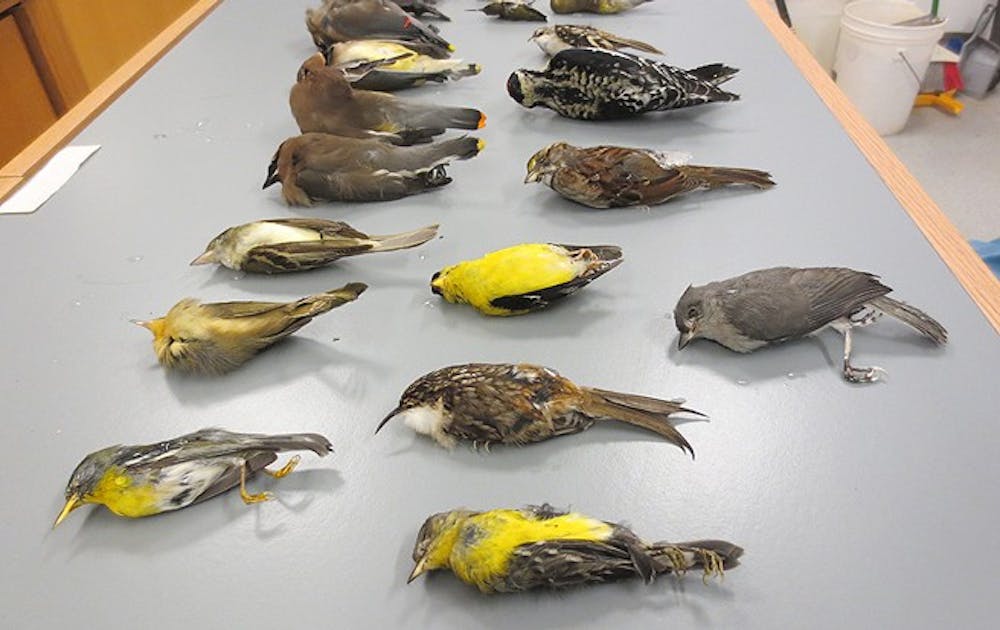As Duke’s architecture moves from gothic stone to sleek glass structures, the University must look at the environmental threat such a design move poses.
When birds pass through Duke on their annual migrations—heading north for the summer and south for the winter—some of them never make it past the glossy new architecture of the Gothic Wonderland. Birds crash into the windows when they either fail to notice the glass altogether or are misled by the reflection of the environment in the windows and fly into the glass. Doing so causes the birds to crash and often die, a fate that has encouraged bird specialist and doctoral student Natalia Ocampo-Peñuela to address the issue.
“A bird that has flown 18,000 km, surviving hawks and the weather and exhaustion, can just hit a window and die,” Ocampo-Peñuela said. “Think about if you sailed around the world and passed all these obstacles and you get to the port and someone shoots you.”
Birds, for Ocampo-Peñuela, constitute both a personal and professional fixation. She wears puffin earrings and has a patch of the colorful cotinga bird sewn onto her backpack. She published two papers on birds as an undergraduate based on her birding club experience. For her thesis, she studies the conservation of threatened birds in her native Colombia, the nation with the most bird species.
Building-related bird deaths are a mostly unquantified phenomenon, but it is estimated that as many as 1 billion birds die every year from crashing into windows, according to the National Audubon Society, a natural conservation group that focuses on birds.
Fewer birds means fewer creatures helping to pollinate, disperse seeds and eat pests, among other ecologically important activities, Ocampo-Peñuela said.
Ocampo-Peñuela tackles the issue at Duke by gathering evidence of bird collisions and working with administrators to make the University’s windows safe for Duke’s feathered friends.
In order to document the frequency of bird-window collisions on campus, Ocampo-Peñuela and her colleagues have begun collecting the bird carcasses that they and their friends encounter.
“We have about 40 birds in the freezer that we know are from bird-window collisions, but that’s without making an effort to find them all,” she said.
Efforts to document the full number of bird deaths are complicated by the presence of feral cats on campus, Ocampo-Peñuela said. Collisions frequently happen in the early morning, and the cats eat the birds before anyone notices they are there.
The Events Pavilion, a glass-walled structure that will house food vendors during the West Union Building renovation, could pose a threat to birds migrating through campus. Ocampo-Peñuela contacted Stephen Carrow, who is in the Events Pavilion planning group, and was told that some windows will be “fritted”—a technique that embeds a pattern in the glass so birds can see it. Still, much of the glass will remain clear.
“Even though this is better than no fritting, I do not think this will be enough to avoid collisions,” she said.
From there she went to Larry Moneta, vice president for student affairs, who is involved in planning the West Union renovation project.
By that time, the windows had been installed in the Events Pavilion, Moneta said.
“I passed on what seems to be an important and reasonable concern to the construction teams,” he noted. “They assured me that much of what was raised has been taken care of in the Pavilion designs.”
She also met with Nicholas School of the Environment leaders regarding the new Environment Hall, which is scheduled to open next March with a wall of windows extending out of the existing Levine Science Research Building.
The new building had the potential to be “a pretty significant issue” for birds, said Prasad Kasibhatla, senior associate dean for academics of the Nicholas School, who has worked with Dean of the Nicholas School Bill Chameides on finalizing the building design. The issue resolved itself, though, because of the environmentally sustainable window design selected for the structure. The fritted glass chosen to reduce direct sunlight -—and therefore thermal heat— from entering the building, also makes the windows visible to birds.
The design was inspired by a leaf pattern found in a grille in Duke Chapel, Kasibhatla said.
“It’s bird safe, it’s energy efficient,” he said. “The dean and I were working with the architects to find what pattern best exemplified what our school was about, but also our connection to Duke and our history.”
For new glass buildings, it is possible to order windows with a UV coating on one of the glass layers that makes patterns visible to birds without obstructing human vision, Ocampo-Peñuela said. These windows could be installed in the glass component of the remodeled West Union.
Moneta noted that the glass for the West Union has not been chosen yet, as the design team is still working on the base architecture. He added that he conveyed the information on bird safety to “everyone involved in the West Union project.”
A different procedure, however, is needed to convert previously installed windows to bird-safe windows.
“You can put a pattern on it, but it has to be no more than 10 cm apart or it won’t work,” Ocampo-Peñuela said. “People that work with buildings and the ones that donate the money want the building to look pretty, and if you put dots on all the windows it might not look as pretty.”
UV paints exist that can be applied to windows to deter birds, but they are not commercially available. Ocampo-Peñuela sees this as an opportunity for interdisciplinary invention. Teams from the environmental school could work with engineering students to design a substance that would warn birds away from windows without obstructing the view.
“I see it as an opportunity for Duke to pioneer in something that hasn’t been taken care of in a lot of universities, or even a lot of places,” she said.
Get The Chronicle straight to your inbox
Signup for our weekly newsletter. Cancel at any time.

